Intel Announces Thunderbolt 4 Specification, Debuts with Tiger Lake
One USB-C cable to rule them all
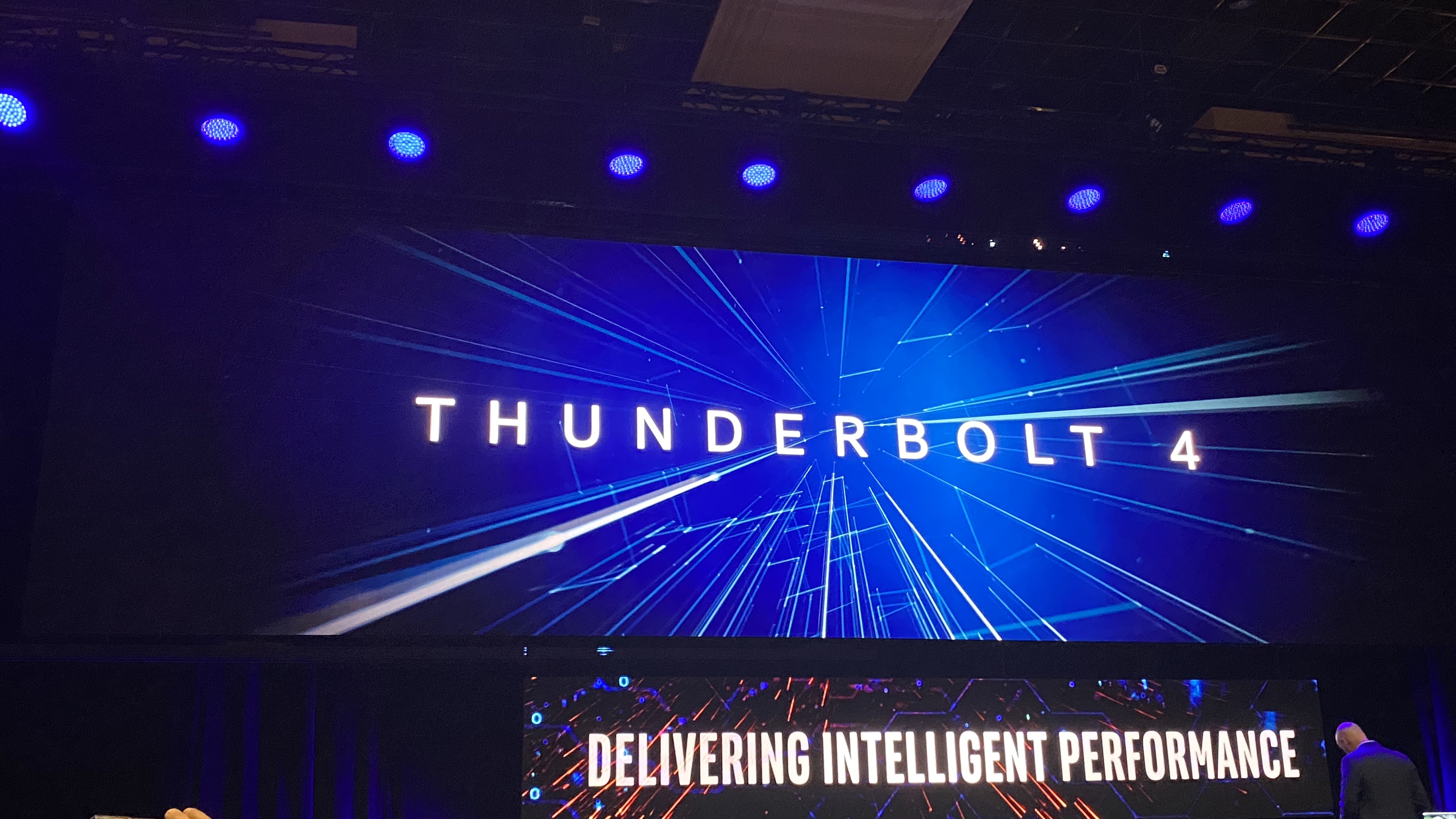
Intel teased the Thunderbolt 4 interface earlier this year at CES 2020 with little detail, though a bit of digging revealed that the new interface isn't faster than the existing Thunderbolt 3. With speeds up to 40Gb/s, Thunderbolt 4 maintains the same maximum speed rating as its predecessor and doesn't enable new features.
However, the new specification requires vendors to enable all of the optional features built into Thunderbolt 3, like the ability to hit the 40Gb/s data throughput requirements and support two 4K displays or one 8K display, in order to qualify for Thunderbolt 4 certification. The specification will debut with Intel's Tiger Lake processors.
The specification also requires support for PC charging on at least one computer port (for devices under 100W) and support for Intel's existing VT-d based DMA protection, which plugs a security hole in the Thunderbolt interface that allowed devices to access system memory. This feature is required with the specification, which doesn't make it clear whether or not AMD-powered systems can achieve Thunderbolt 4 certification. Intel responded that the spec is available to AMD, but hasn't clarified how AMD could bring its systems into compliance without support for VT-d, or if such an arrangement can be enabled. [EDIT: Intel reached out to clarify that AMD, and other vendors, can use Thunderbolt 4 with equivalent DMA protection technology] This could be a sticking point, as AMD systems with even Thunderbolt 3 certification are still a rarity.
Intel also announced new 8000-series controllers that will bring support for four ports on Thunderbolt 4 (TB4) docks. The new silicon will power a new wave of Thunderbolt docks that feature one upstream connection to the PC and three downstream connections to attached peripherals, like storage devices and monitors.
Intel contributed the Thunderbolt 4 specification to the USB standards committee last year to further adoption of the Thunderbolt interface, and the unficiation of the two standards, along with forced compliance with all of the features of Thunderbolt 3 and USB4, is designed to simplify the confusion surrounding the cornucopia of different ports and cables used for both USB and Thunderbolt interfaces. In the end, that could help the industry unify the current fragmented cable and port compatibility into one type of USB-C type cable for both the USB and Thunderbolt interfaces.
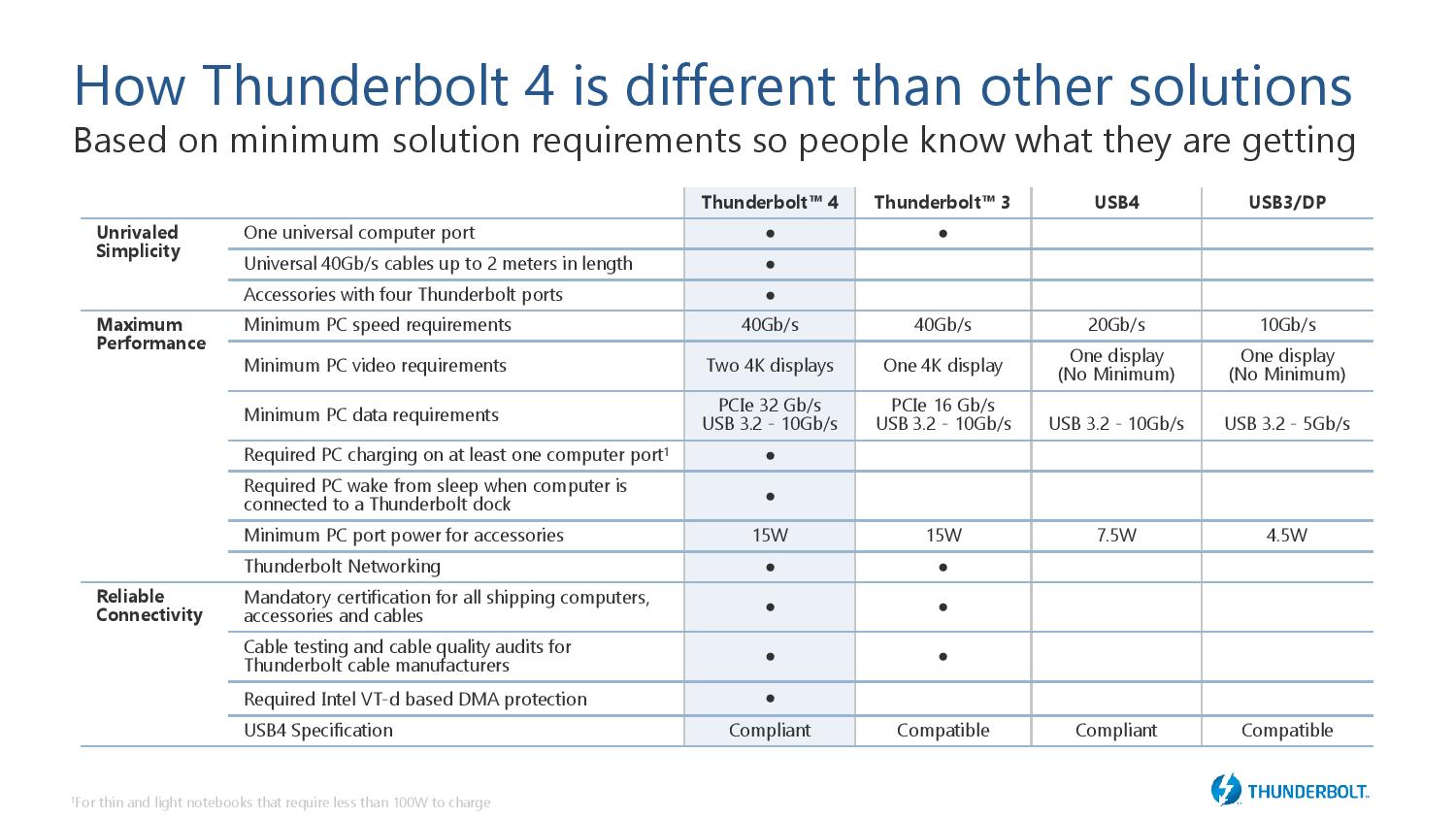
The table above shows the minimum level of support that vendors, like PC makers, have to enable to gain the Thunderbolt certification badge. All of the features we see enabled on the Thunderbolt 4 column already exist in the Thunderbolt 3 specification, but many of those features, like the ability to hit the maximum rated 32Gb/s of throughput, support for PC charging, and USB4 compliance, were previously optional.
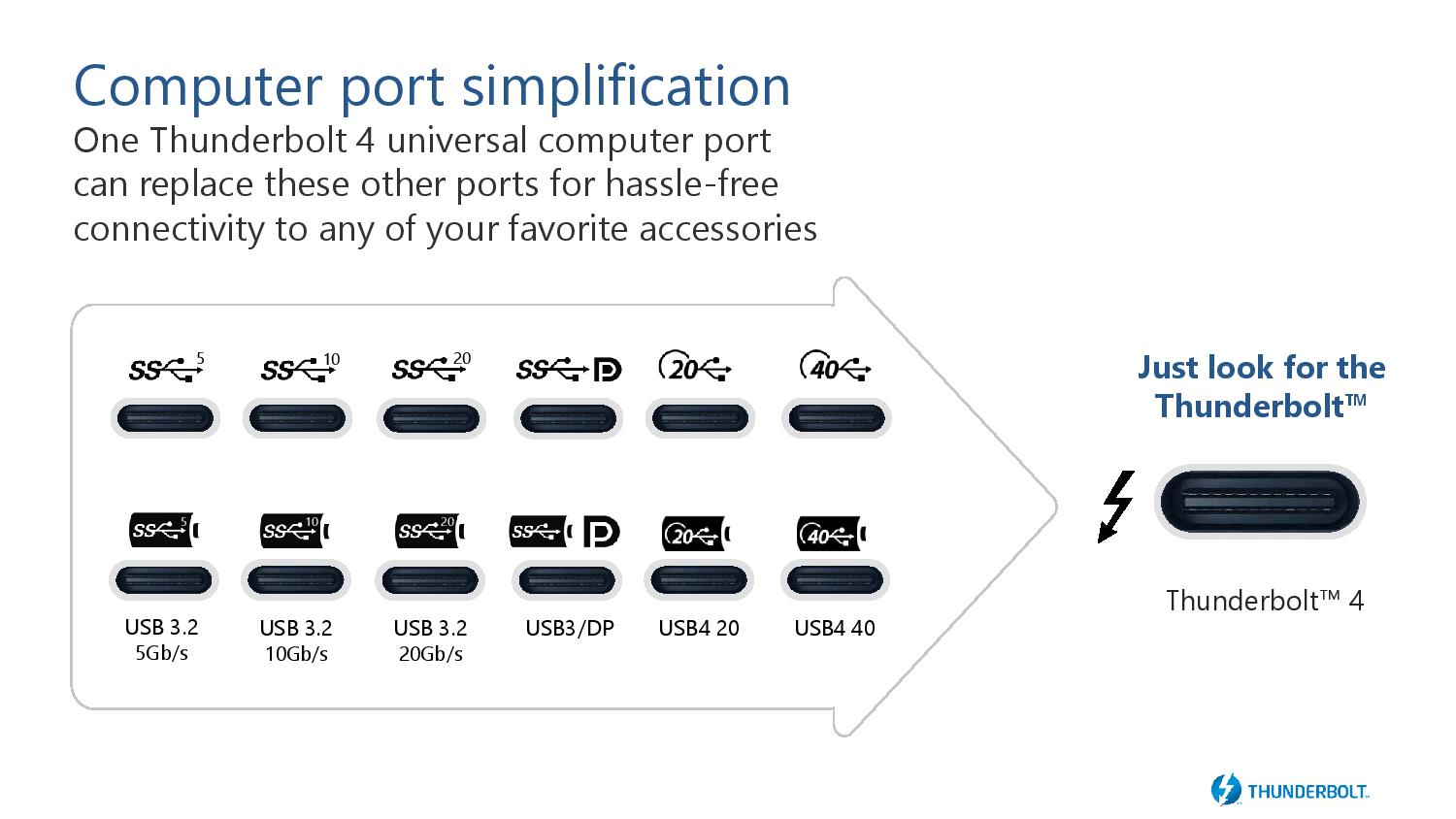

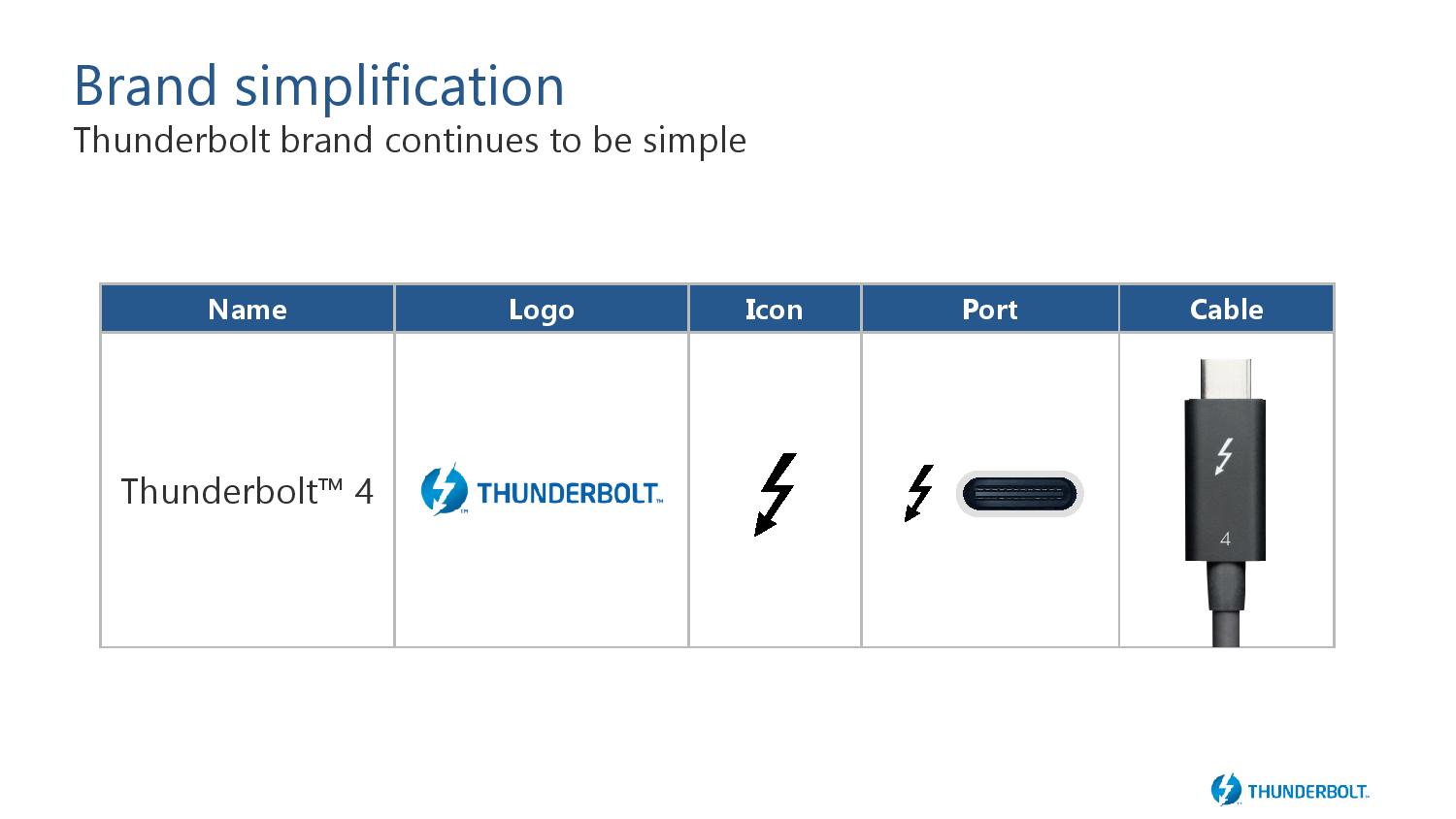
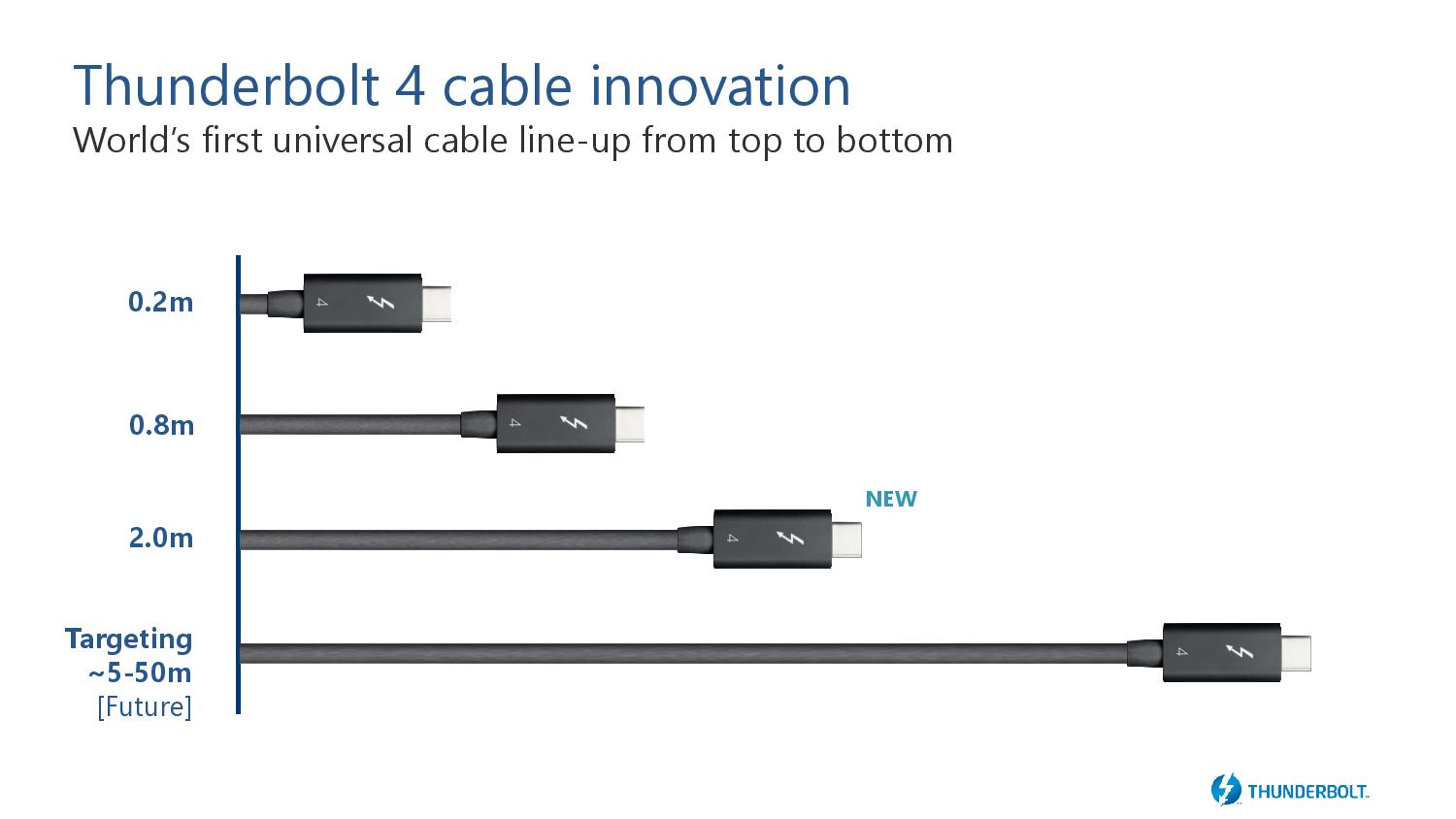
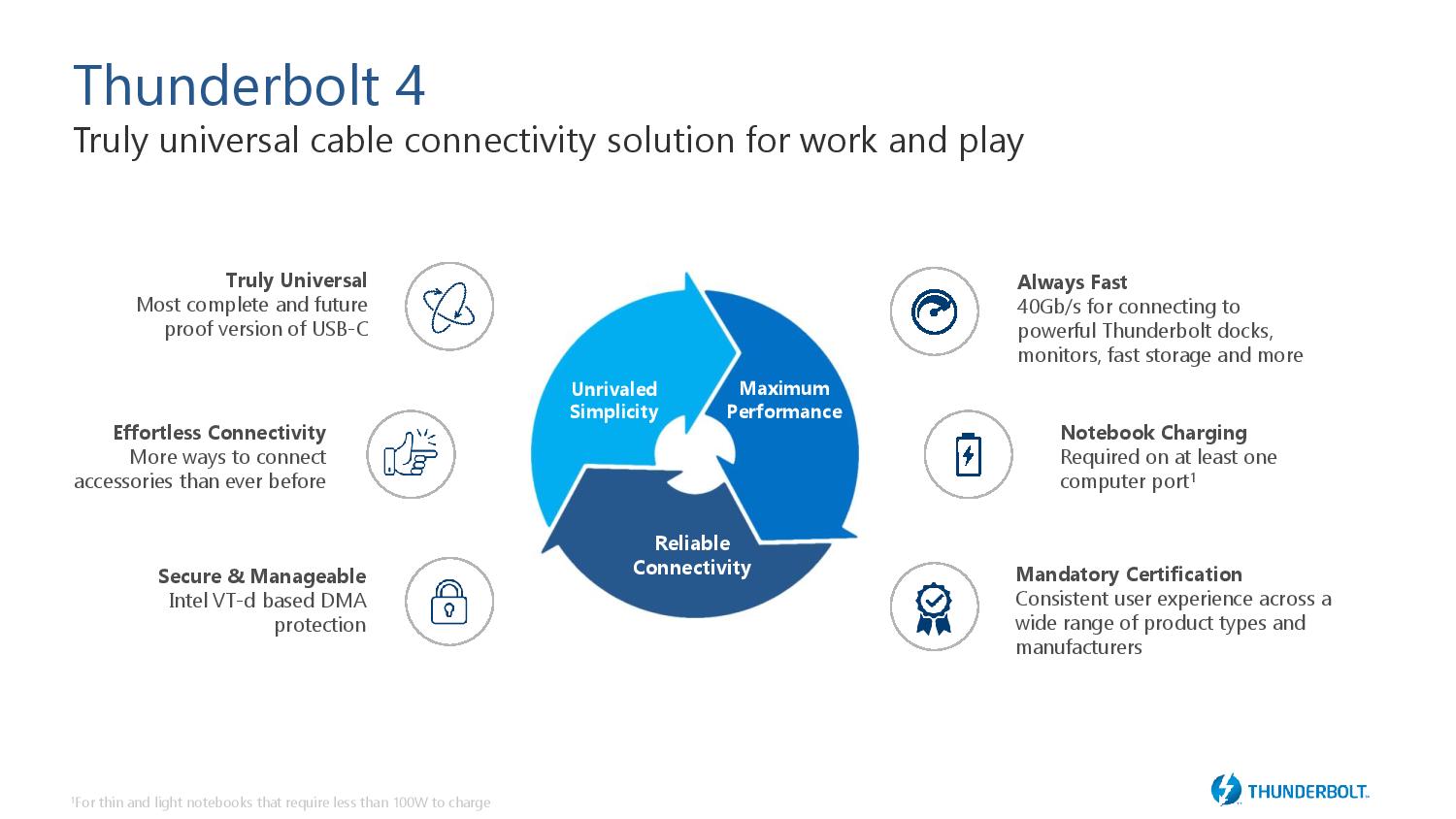
Thunderbolt 4 also calls for universal cables (up to 2 meters in length) that support 40Gb/s of throughput, addressing the current confusing array of different types of USB-C cables and ports into one central solution that has a simplified branding scheme (a single lighting bolt logo). Thunderbolt 4 cabling will come in 0.2m, 0.8m, and 2m lengths, with plans for 5 to 50m cabling in the future.
Get Tom's Hardware's best news and in-depth reviews, straight to your inbox.
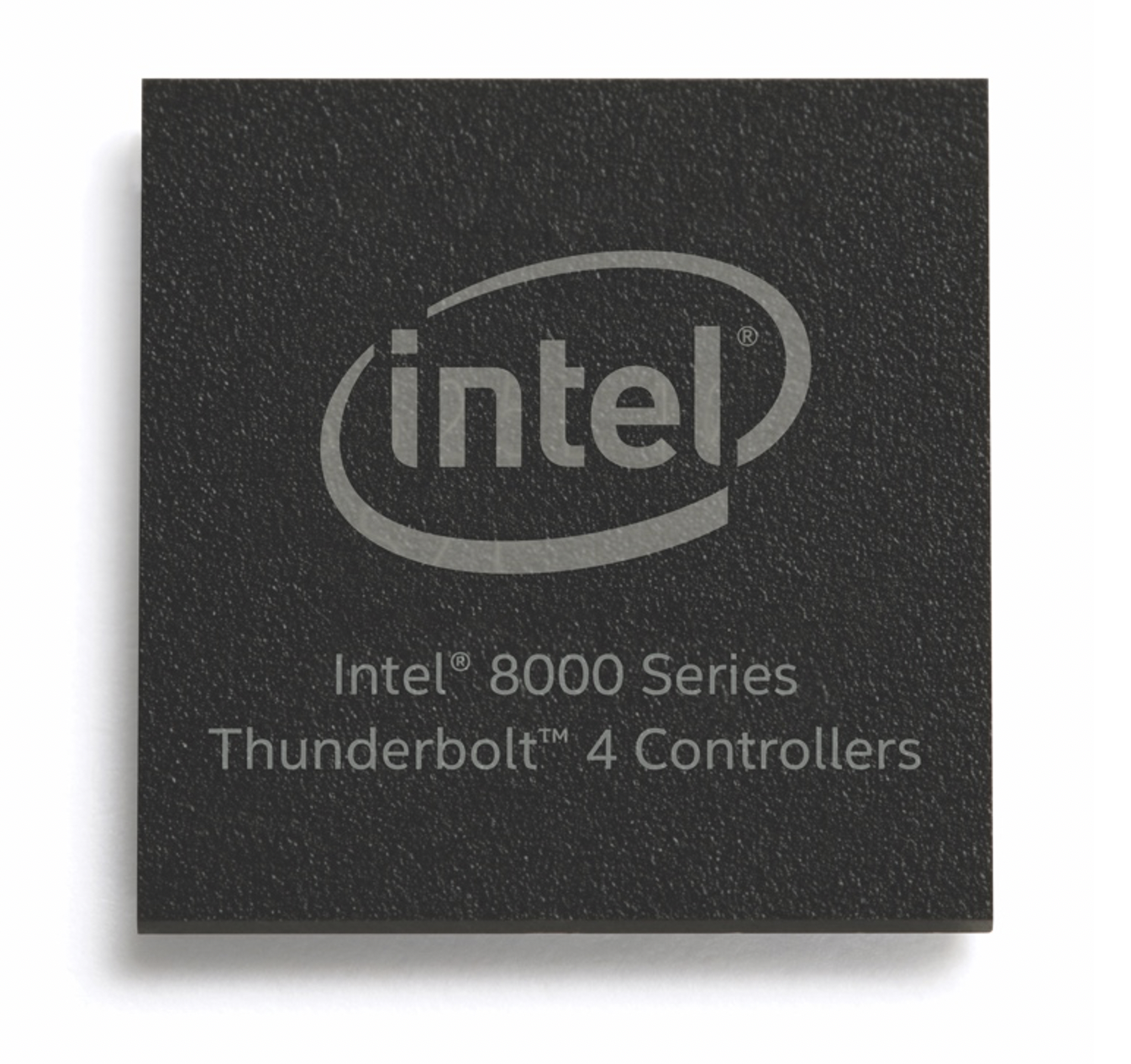
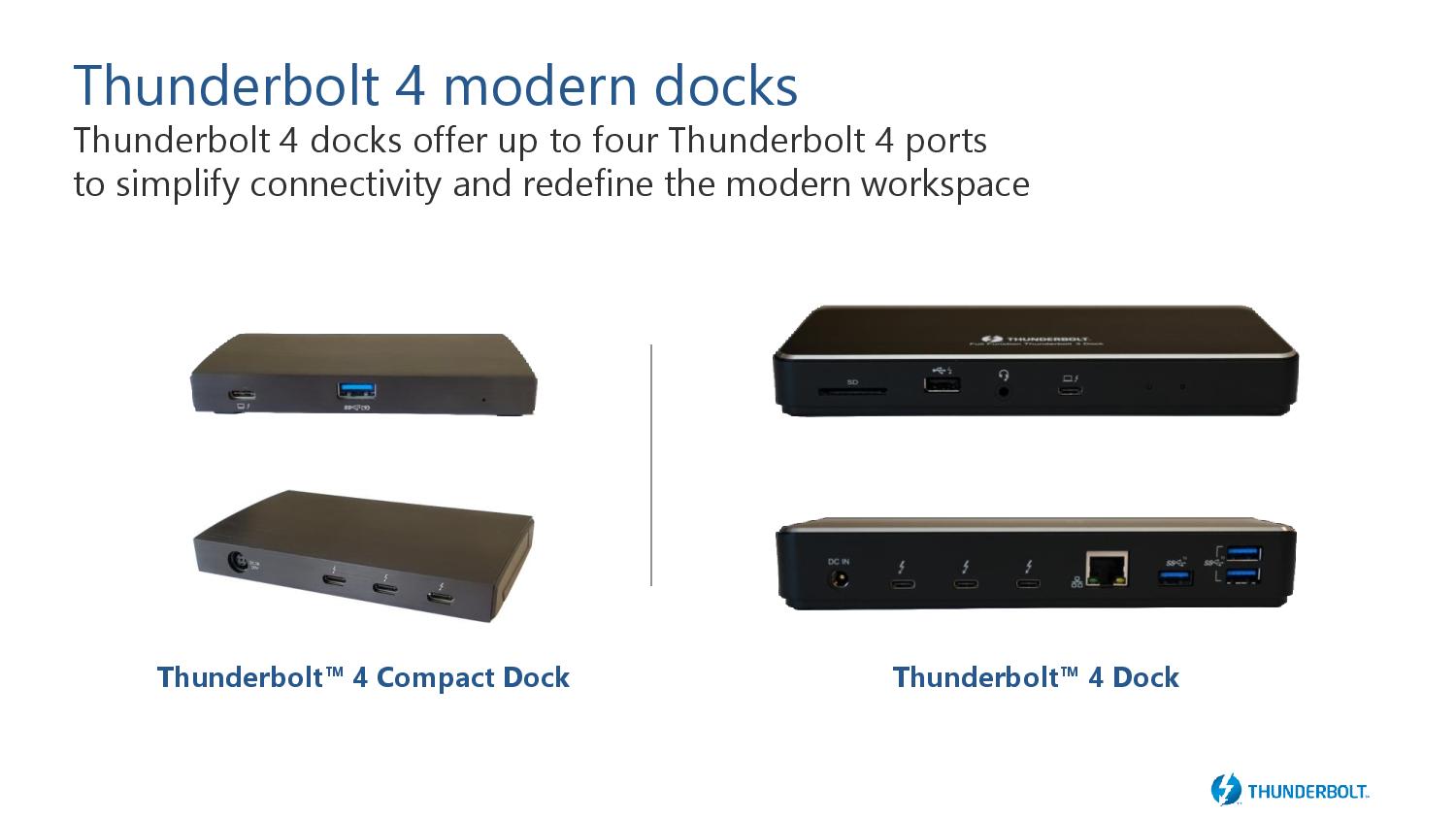
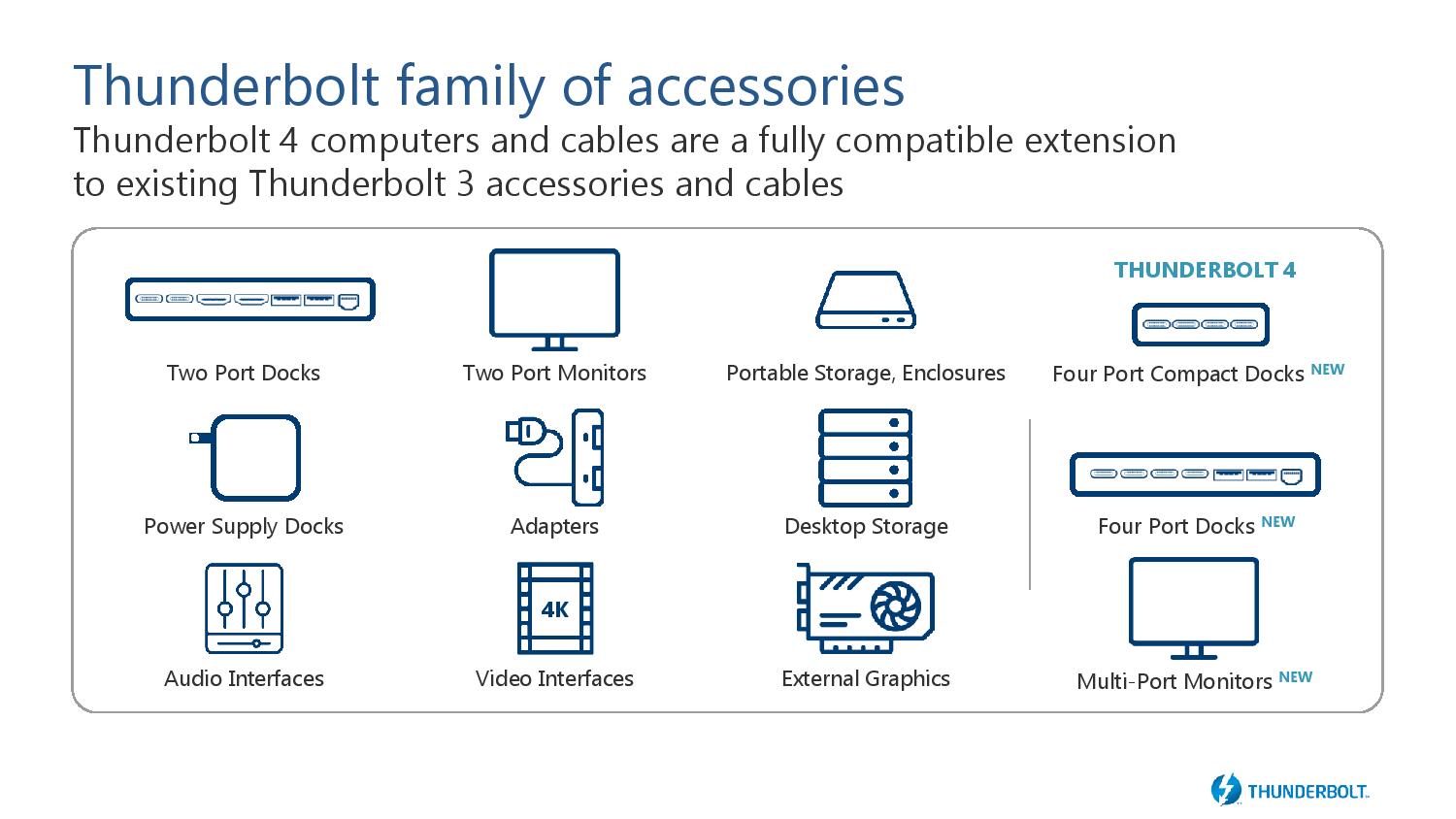
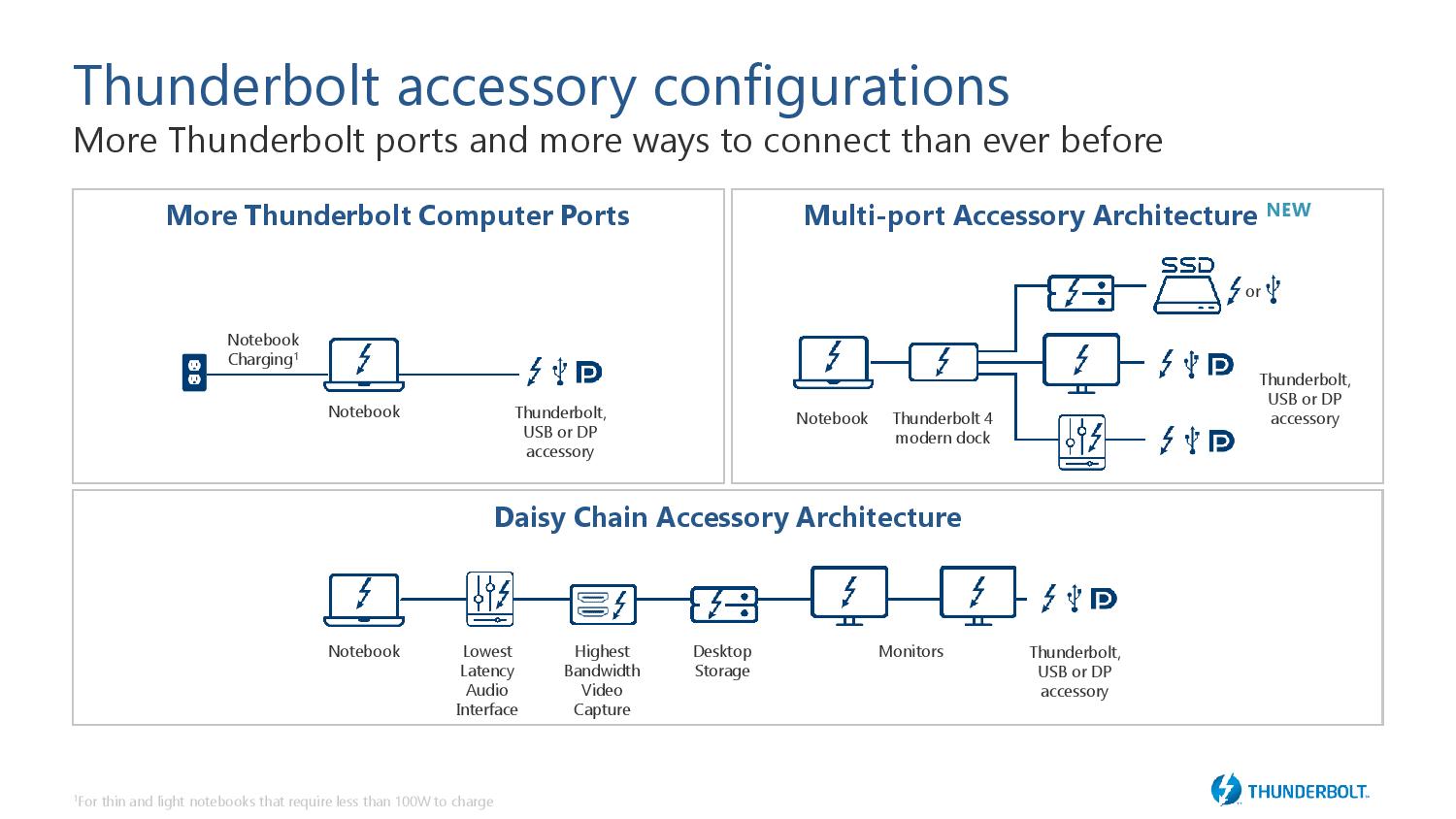
Intel's 'Maple Ridge' 8000-series Thunderbolt 4 controllers includes JHL8540 and JHL8340 host controllers for PC vendors, which will allow integration with systems powered by other types of processors, and the JHL8440 device controller for accessories. Intel says it has made developer kits and certification testing available for vendors. The first Thunderbolt 4 systems will arrive later this year, including with Athena 2.0 laptops, and accessories will also become available.
Manufacturers of end devices pay a one-time fee for Thunderbolt 4 certification and relevant trademark licensing, which are the only payments required to obtain the Thunderbolt 4 badge, but cable makers are subject to ongoing rigorous inspections that include spot checks and factory audits to ensure that quality remains acceptable on an ongoing basis. Intel also hosts plugfests, during which interoperability with numerous new devices is tested, and workshops.

Paul Alcorn is the Editor-in-Chief for Tom's Hardware US. He also writes news and reviews on CPUs, storage, and enterprise hardware.
-
Giroro Its basically the of thing, but Intel made the number higher?Reply
Looks like Intel's executives are still really hard at work earning those giant paychecks. -
shady28 ReplyGiroro said:Its basically the of thing, but Intel made the number higher?
Looks like Intel's executives are still really hard at work earning those giant paychecks.
Actually pretty useful stuff for the consumer. Unified cabling standards is nice.
Also, truth in marketing is nice :
"the new specification requires vendors to enable all of the optional features built into Thunderbolt 3, like the ability to hit the 40Gb/s data throughput requirements and support two 4K displays or one 8K display, in order to qualify for Thunderbolt 4 certification. " -
nofanneeded Replyshady28 said:Actually pretty useful stuff for the consumer. Unified cabling standards is nice.
Also, truth in marketing is nice :
"the new specification requires vendors to enable all of the optional features built into Thunderbolt 3, like the ability to hit the 40Gb/s data throughput requirements and support two 4K displays or one 8K display, in order to qualify for Thunderbolt 4 certification. "
hahahaha , so being truthful in marketing now needs a new name and a new generation ? Really? so what you are saying is : Intel was cheating in TB 3 and in TB 4 stopped cheating right ?
be careful dude , if you want vendors to enable all features , while giving the same tech , this is not a new thunderbolt ... it can be done without faking a new name and giving the same thing. -
z3mr2 Replythe new specification requires vendors to enable all of the optional features built into Thunderbolt 3, like the ability to hit the 40Gb/s data throughput requirements
So TB3 40Gb is false advertising? Intel knowingly told vendors not to provide the full 40Gb throughput available in Thunderbolt 3 but was advertised as a 40Gb throughput connectivity.
Another issue, how are we going to differentiate TB3 and TB4 ports and ultimately the cables! -
AnimeMania It is just a way to make Apple and AMD look bad since neither of their CPUs will not be able to qualify for the new standard. The latest Thunderbolt standard comes out and Apple can't use it, Most of the people who care about Thunderbolt are Mac users.Reply -
Jennifer W I thought USB4 was supposed to incorporate Thunderbolt as well, so we could use a single cable and interface type for both USB & Thunderbolt devices...Reply
But this sounds like TB4 and USB4 are going to be two completely different things, that just happen to use the same cable/plug type.
Am I getting that correct?
If that’s the case, I’m really not as excited for it as I was before.
Here I was thinking the two would be unified as a single new standard all under USB4. -
spongiemaster Reply
USB4 is a subset of TB4, so any usb device that uses the type c connector will work with TB4 ports if you're using a TB4 spec cable, but you can't plug a TB4 device into a USB4 port.Jennifer W said:I thought USB4 was supposed to incorporate Thunderbolt as well, so we could use a single cable and interface type for both USB & Thunderbolt devices...
But this sounds like TB4 and USB4 are going to be two completely different things, that just happen to use the same cable/plug type.
Am I getting that correct?
If that’s the case, I’m really not as excited for it as I was before.
Here I was thinking the two would be unified as a single new standard all under USB4. -
Jennifer W Reply
See that’s what I’m getting at. I thought TB4 and USB4 were being merged so that there would only be one port (a type c port) which could accept either TB or USB devices.spongiemaster said:USB4 is a subset of TB4, so any usb device that uses the type c connector will work with TB4 ports if you're using a TB4 spec cable, but you can't plug a TB4 device into a USB4 port.
But the way this sounds, there will be a type c port that lets you use TB or USB.... and another that is USB only. -
spongiemaster Replyz3mr2 said:So TB3 40Gb is false advertising? Intel knowingly told vendors not to provide the full 40Gb throughput available in Thunderbolt 3 but was advertised as a 40Gb throughput connectivity.
No, chief. The controllers are all capable of 40Gb. What determines the actual transfer speed and feature set is the cable you use and this has always been made crystal clear. Passive copper cables (basically a USB type C cable) are only capable of 20Gb. Active copper is capable of 40Gb up to 6 feet. Active optical are theoretically capable of 40Gb up to 200ft though I don't think anyone sells a cable that long. Also, while copper variants can carry power and support USB C devices, optical cables which also need to use an optical port do not. -
spongiemaster Reply
Correct. If the two standards were exactly the same, what would be the point of having two different names for the same standard?Jennifer W said:But the way this sounds, there will be a type c port that lets you use TB or USB.... and another that is USB only.